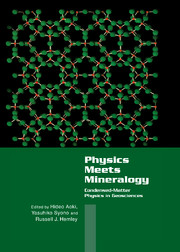Book contents
- Frontmatter
- Contents
- Preface
- List of Contributors
- Part I Introduction
- Part II Advances in Theoretical and Experimental Techniques
- Part III New Findings in Oxides and Silicates
- Part IV Transformations in Silica
- Part V Novel Structures and Materials
- Part VI Melts and Crystal–Melt Interactions
- Chapter 6.1 Comparison of Pair-Potential Models for the Simulation of Liquid SiO2: Thermodynamic, Angular-Distribution, and Diffusional Properties
- Chapter 6.2 Transport Properties of Silicate Melts at High Pressure
- Chapter 6.3 Structural Characterization of Oxide Melts with Advanced X-Ray-Diffraction Methods
- Chapter 6.4 Computer-Simulation Approach for the Prediction of Trace-Element Partitioning Between Crystal and Melt
- Subject Index
- Materials Formula Index
- Index of Contributors
Chapter 6.4 - Computer-Simulation Approach for the Prediction of Trace-Element Partitioning Between Crystal and Melt
Published online by Cambridge University Press: 05 November 2011
- Frontmatter
- Contents
- Preface
- List of Contributors
- Part I Introduction
- Part II Advances in Theoretical and Experimental Techniques
- Part III New Findings in Oxides and Silicates
- Part IV Transformations in Silica
- Part V Novel Structures and Materials
- Part VI Melts and Crystal–Melt Interactions
- Chapter 6.1 Comparison of Pair-Potential Models for the Simulation of Liquid SiO2: Thermodynamic, Angular-Distribution, and Diffusional Properties
- Chapter 6.2 Transport Properties of Silicate Melts at High Pressure
- Chapter 6.3 Structural Characterization of Oxide Melts with Advanced X-Ray-Diffraction Methods
- Chapter 6.4 Computer-Simulation Approach for the Prediction of Trace-Element Partitioning Between Crystal and Melt
- Subject Index
- Materials Formula Index
- Index of Contributors
Summary
A computer-simulation procedure for predicting the trace-element partition coefficient between crystal and melt is presented. It is a modified version of Nagasawa's model. The enthalpy change for trace-element partitioning between crystal and melt is approximated as the partial excess enthalpy of trace-element substitution in the crystal, which can be obtained by calculation of the enthalpy change of the crystal before and after substitution by means of molecular-dynamics simulation. As a test of the procedure, the partial excess enthalpies for trace cation substitution in KC1, diopside (CaMgSi2O6), and forsterite (Mg2SiO4) crystals were calculated. When the partial excess enthalpy is plotted against the size of the substituent cations, it has a minimum at the host cation position. Withan increasing degree of misfit to the host ion site, the partial excess enthalpy increases. The calculation thus qualitatively reproduced the partitioning behavior observed in the Onuma (partition coefficient versus ionic radii) diagrams. The merit of this procedure is that it allows us to predict trace-element partitioning behavior even at extreme conditions solely from interatomic potentials.
Introduction
Partitioning of elements between minerals and melt (or fluid) is one of the most important factors in determining the elemental distribution in the Earth during its evolution. To understand geochemical processes by means of elemental distributions recorded in rocks, the partition coefficients of major and trace elements between minerals and melt (or fluid) have been measured (e.g., Ref. [1]). However, much less effort has been applied to understanding the partitioning behavior from a microscopic perspective.
- Type
- Chapter
- Information
- Physics Meets MineralogyCondensed Matter Physics in the Geosciences, pp. 381 - 390Publisher: Cambridge University PressPrint publication year: 2000
- 2
- Cited by



